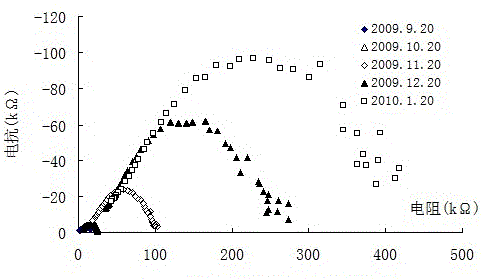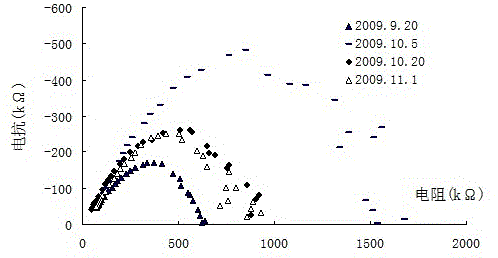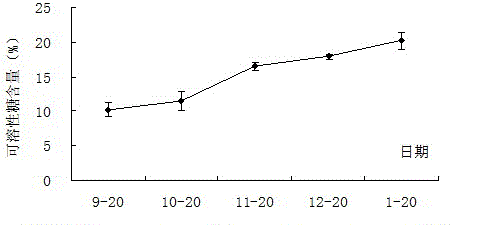Electrical impedance method for measuring soluble sugar content in catalpa bungei stem leaf and cold resistance of catalpa bungei
A measurement method, electrical impedance technology, applied in the direction of material impedance, etc., can solve the problems of cumbersome, destructive hysteresis, and cannot meet the needs of fast and real-time production
- Summary
- Abstract
- Description
- Claims
- Application Information
AI Technical Summary
Problems solved by technology
Method used
Image
Examples
Embodiment 1
[0108] After the stems were washed and dried with deionized water, they were packed into plastic bags respectively, repeated 8 times, and a small amount of deionized water was sprayed into the bags to prevent the material from being too cold. Seven temperature gradients (see Table 1) were set for the freezing treatment temperature, with 4°C as the control, which included the temperature at which all samples survived and all died. The cooling rate is 6℃·h -1 , kept at the processing temperature for 4 hours, then thawed at 4°C for 24 hours, and then tested.
[0109] Table 1 In Example 1 of the present invention, the determination of the cold resistance of Catalpa spp.
[0110]
[0111] Randomly select 8 sections of 15mm long stems after thawing for electrical impedance measurement:
[0112] Impedance meter (HP4284A, USA) was used for EIS measurement, Ag / AgCl electrode was used in the test, electrode gel was added to the electrode, and the cross-section of the sample was con...
Embodiment 2
[0115] After the leaves were washed and dried with deionized water, they were packed into plastic bags, repeated 8 times, and a small amount of deionized water was sprayed into the bags to prevent the material from being too cold. Seven temperature gradients (Table 2) were set for the freezing treatment temperature, with 4°C as the control, which included the temperature at which all samples survived and all died. The cooling rate is 6℃·h -1 , kept at the processing temperature for 4 hours, then thawed at 4°C for 24 hours, and then tested.
[0116] Table 2 In the embodiment of the present invention 2, the determination of freezing treatment setting temperature of the cold resistance of the leaves of Catalpa catalpa
[0117]
[0118] Randomly select 8 rectangular leaf segments without veins after thawing, the size is 4mm×10mm, and conduct electrical impedance measurement:
[0119] Impedance meter (HP4284A, USA) was used for EIS measurement, Ag / AgCl electrode was used in th...
Embodiment 3
[0122] After washing and drying the stems of Chinese catalpa with deionized water, put them in an oven at 80°C and dry them for 2 days. After taking them out, use the anthrone colorimetric method to measure the content of soluble sugar in them;
[0123] According to the scheme measurement of embodiment 1, 75 groups of samples of Chinese catalpa stem are measured for electrical impedance, obtain the electrical impedance value of 75 groups of golden catalpa stem samples, then with reference to Meng Yu etc. (Meng Yu, Di Bao, Zhang Gang, Feng Feng Xinguo, Xu Jiancheng, Tian Jun. Correlation analysis between soluble sugar and starch content and electrical impedance of birch roots under waterlogging stress. Acta Biophysica Sinica, 2013, 29(6):450~460.) Determination of EIS parameters , using LEVM8.06 software, using the single-DCE model for data fitting, and finally obtained the high frequency resistivity r (Ωm), low frequency resistivity r 1 (Ωm), extracellular resistivity r e (Ω...
PUM
| Property | Measurement | Unit |
|---|---|---|
| thickness | aaaaa | aaaaa |
Abstract
Description
Claims
Application Information
 Login to View More
Login to View More - R&D
- Intellectual Property
- Life Sciences
- Materials
- Tech Scout
- Unparalleled Data Quality
- Higher Quality Content
- 60% Fewer Hallucinations
Browse by: Latest US Patents, China's latest patents, Technical Efficacy Thesaurus, Application Domain, Technology Topic, Popular Technical Reports.
© 2025 PatSnap. All rights reserved.Legal|Privacy policy|Modern Slavery Act Transparency Statement|Sitemap|About US| Contact US: help@patsnap.com



